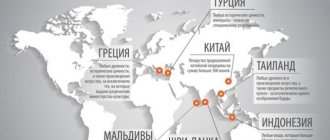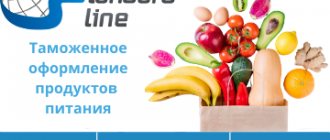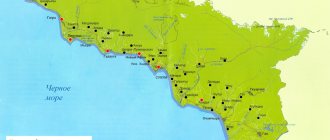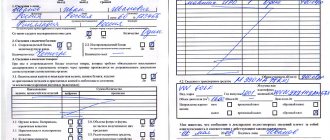4
(5)
Getting a visa is one thing, but getting through US Customs quickly and easily is another thing entirely. In addition to filling out a customs declaration, you also need to carefully understand what can be brought into the United States and what is strictly prohibited. In this article we will try to look at the rules for entering the United States.
What foods can you bring into the United States for personal use?
Those food products that, in your opinion, pose absolutely no threat, may be prohibited from being imported into America. Therefore, you should carefully read the list of products permitted and prohibited for import into the country.
Products that can be brought into the USA for personal use:
- Vegetable oils.
- Bakery products, cookies, cakes, breakfast cereals, etc.
- Chocolate and candies.
- Baked goods, dry mixes, and confectionery products that contain egg and dairy ingredients must be in original packaging with labels.
- Canned food, vacuum-sealed foods. With the exception of those that contain meat and chicken.
- Fish and seafood in fresh, frozen, smoked, dried and prepared form.
- All kinds of dried fruits.
- Dairy products. In quantities designed to be consumed over several days.
- Homemade juices are prohibited from import, only factory-made ones.
- Powdered drinks. If the packaging contains ingredients in English. However, the final decision on the import of this product remains with customs officials.
- Tea in factory packaging. Barberry, coca and leaves of some citrus fruits are prohibited from import.
- Coffee without casing, both roasted and not.
- Various spices. These also include ready-made sauces that do not contain meat. The exceptions are the grains and leaves of citrus fruits, lemongrass, and most fruit and vegetable grains.
- Honey.
- Instant noodles and packaged pasta that do not contain eggs or meat.
- Corn, oat, wheat and rice flour.
- Cereals, for example, buckwheat, are allowed to be imported if they have original packaging indicating their composition.
- Rice without shell. For countries where the carpet beetle lives, the import of rice into the United States is prohibited.
- Mushrooms, peeled from soil.
- Nuts.
Is it possible to import red caviar?
allowed to be imported into the United States , but it must comply with established standards. Caviar must be in plastic, metal or glass original packaging indicating the expiration date, manufacturer, labeling and certification. Another condition for transporting caviar to the USA is compliance with the established norm - no more than 125 g per person . In addition, it is better to keep receipts for the purchase of this product, since they may be required during customs inspection.
If you take any of these products to America as a gift or for yourself in reasonable quantities, you will avoid any problems at customs control.
What is prohibited from taking on board the plane?
For travelers who fly infrequently, it is worth knowing what exactly you cannot take in hand luggage. Carriers' requirements may vary, but the general rules are the same. Knowing them will help you avoid possible problems when boarding a plane.
Carry-on baggage sizes sometimes vary depending on the airline. Typically, a bag or suitcase should fit within these parameters.
The sum of the three measurements must be no more than 115 cm. The weight of hand luggage is limited to 5-10 kg. The exact numbers need to be clarified with the selected airline.
It will not be possible to deceive airport workers, because verification of compliance with these dimensions is carried out using a special frame and scales.
- Scissors, manicure sets. It is acceptable on some airlines to take a file with a rounded tip into the cabin.
- Knitting needles, crochet hooks, sewing needles.
- Corkscrew, knives, including penknives and stationery ones.
- Syringe needles. You can take them with you only if you have a doctor’s certificate.
The ban also applies to straight razors. But these do not include models with replaceable attachments or disposable machines. Also, deodorants, hairspray or hair styling foam, which are made in the form of an aerosol, cannot be carried into the salon.
You also cannot take Segways, hoverboards, electric scooters, etc. with you. It is permissible to take a baby stroller on board if its dimensions meet the standards for hand luggage.
You should always check with the carrier for a list of what you can bring on the plane. It is usually acceptable to take food, personal care products, medicines and other items with you during the flight.
You can bring snacks on board in the form of nuts, apples, bananas, sandwiches with hard cheese or sausage. Cookies and chips, sweets, and fitness bars are not prohibited.
If you need to take dry ice to cool perishable foods, then often the permissible amount is no more than two kilograms per person.
From medications you can take tablets, capsules, powders. And liquid syrups, drops, gels, creams, peroxides should also be poured into 100 ml bottles. The exception is for vital medications if you have a doctor’s certificate.
- The drugs must be in the manufacturer's packaging.
- Prescription medications are transported along with a prescription or a doctor’s certificate.
- Medicines containing psychotropic substances can be taken with you if you have a prescription from a doctor indicating the name of the drug in Latin. When flying abroad, the drug will need to be declared.
Before traveling abroad, check the list of medications that can be imported into your destination country, as strict restrictions may apply, such as in the UAE and the USA.
In your carry-on bag you can only take cosmetics in solid form - powder, blush, loose highlighter, shadows, eyeliners, eyebrows, lips.
Liquid eyeliner and lipstick, lip glosses, foundation and concealer must be checked in luggage. The same applies to creams, shampoos and deodorant.
You can take a laptop, tablet, photo and video camera with chargers for them into the salon. Mobile phones must be put into airplane mode. The only smartphone model that will not be allowed to be carried on board or checked in as luggage is the Samsung Galaxy Note 7.
You can also take a hair dryer, straightener and curling iron with you. Air carriers will even allow you to take a slow cooker if it fits into the dimensions.
Always keep your child's passport or birth certificate with you, especially when flying abroad. Sometimes luggage is sent on a different flight or it may get lost. As for valuables, you can take jewelry, costume jewelry, and a wallet with you.
You are allowed to take a toothbrush and toothpaste into the salon; the comb must not have a handle. It is permissible to bring wet wipes, baby diapers, and feminine hygiene items.
Containers for any liquid substances should be 100 ml. If you take an incompletely filled bottle of a larger volume, it will not be allowed through. The only exception is baby food.
It is permissible to bring juices, water, and other drinks poured into small containers. One passenger can take no more than a liter of liquids with him.
All this does not apply to duty-free purchases - drinks, perfumes and the like. The main thing is that you have the purchase receipt and the whole package in your hands. You should not open packages from Duty Free before leaving for the destination city, so that restrictions do not apply to them.
Study especially carefully the requirements for hand luggage from foreign carriers. They often turn out to be tougher than those of Russian airlines. The same rule applies to flights - when flying abroad, the rules will be much stricter than within the country.
How do I find out what fruits and vegetables are allowed to be brought?
Sometimes it is very difficult to understand whether a particular fruit or vegetable can be imported into the United States. Many people do not know even half of those that currently exist, since their diversity is truly impressive. Whether there is permission to import certain types of vegetables and fruits to America can be checked using a special database.
- To make sure that the fruit or vegetable you are interested in can be imported into America, you should select your country from the drop-down list in the Country/Region field.
- As a result, a list of all products that can be transported from this state to the United States will appear on the screen.
- In addition, by pressing the “CIR” button next to the desired vegetable/fruit, you can see additional requirements for its transportation. For example, only underground parts of a vegetable can be transported or a special permit is required to import it. If you select the product of interest in the Approved Name field, the result will be a list of countries from which it is allowed to be transported to the United States.
For example, ginger root can be transported from Ukraine to the USA through all ports. At customs, employees are required to inspect it, guided by the general rules of customs control. No permit is required to import ginger for personal use; however, to import batches of ginger for commercial purposes, a special phytosanitary certificate is required.
If the product you select is approved for import into the United States, you will see the following information on the screen:
Found N positions indicating product and country. For further information, you need to click on “CIR” next to them. As a result, you will have the following data:
- Admissible Plant Parts – part of a plant (underground or above ground) allowed for import into the country.
- Admissible Ports – ports acceptable for the import of fruit/vegetables.
- Subject to Inspection – the goods are subject to inspection upon arrival at the port.
- Import Permit Required – appropriate import permission is required.
- Condition of entry treatment – this vegetable/fruit cannot be transported into the country in passenger luggage.
Here are some of the vegetables that are allowed to be imported from Ukraine, Russia and Belarus to America:
- ground parts of aloe;
- ginger roots;
- peeled garlic cloves, etc.
Regardless of the import status of fruits/vegetables, they must be handed over to a qualified agricultural commodities officer for inspection at customs. To obtain an import permit, products must be clean, free from insects and signs of disease.
From scissors to alcohol
| Thing | Hand luggage | Baggage |
| Straight razor, machine with double-sided blades | It is forbidden | Can |
| Fork | More often it is not possible, but they may be allowed to be carried in hand luggage. | Can |
| Knitting needles | More often it is not possible, but they may be allowed in hand luggage, especially plastic and wooden knitting needles. | Can |
| Stationery knife | It is forbidden | Can |
| Nail clippers and file, tweezers | Some countries and airlines allow you to take all this in hand luggage, while others take it away. It's safer to check it in your luggage. | Can |
| Ice ax | It is forbidden | Can |
| Sword, dagger, saber, cleaver, scimitar | It is forbidden | Feel free to check it in as luggage if it looks like a clear souvenir or you have a certificate stating that these are household tools. |
| Multitool with blades | It is forbidden | Can |
| Knife | Knives with blades up to 6 cm and knives with rounded ends, for example, for butter, are sometimes allowed in hand luggage. | Can |
| Scissors with blades longer than 6 cm | It is forbidden | Can |
| Scissors with blades shorter than 6 cm | Some items may be allowed in hand luggage, but are often prohibited, including children's scissors with rounded edges. | Can |
| Disposable razor, razor with replaceable cassettes | Can | Can |
| Hunting knife | It is forbidden | Transport in a case. Warn the airline in advance that you are carrying a hunting knife, and during security show your hunting ticket with the knife number written on it. |
| Saw, including chain saw | It is forbidden | Can |
| Axe | It is forbidden | Can |
| Sewing needle | Usually prohibited, but may be allowed in hand luggage. | Can |
| Corkscrew | It is forbidden | Can |
| Electric razor | Can | Can |
You can check in alcohol in your luggage if it is no stronger than 70%. Whether alcohol will be allowed in hand luggage depends on the laws of the country and the rules of the airline. This is allowed in the USA. Russian laws are vague. In any case, you cannot drink your own alcohol on board the plane. You need a glass for courage - wait until the flight attendants offer it or order from the menu if the flight is not alcohol-free.
In cases where alcohol is allowed in hand luggage, it must be in branded bottles of a maximum of 100 ml. Pack them together with other liquids in a zip lock bag measuring 20x20 cm. Alcohol from duty free can be taken in larger bottles, but they must be in a branded sealed bag with a receipt.
How much alcohol you can carry by plane depends on airport security and customs regulations. What they miss during pre-flight inspection, customs officers can turn away: their requirements are often more stringent. There are no general rules, customs in each country is different, so double-check the rules before flying.
Baby food is not subject to restrictions on the carriage of liquids and gels in hand luggage. This means you can take into the cabin as much water, milk, formula and baby food (usually up to 2 years) as you need for the duration of the flight. Even if the containers are more than 100 ml, you will not break anything.
Medicines are subject to restrictions on the transport of liquids. You can take medicines in solid forms in your hand luggage. Liquids, ointments, gels, syrups, creams and aerosols are also possible, but in containers up to 100 ml, packaged in one transparent bag measuring 20x20 cm. An exception is medications that are vital in flight, for example, for patients with diabetes. Take them in containers of the required size, just bring a doctor’s certificate.
| Thing | Hand luggage | Baggage |
| Aerosol can of paint | It is forbidden | It is forbidden |
| Gasoline, diesel, alcohol, ethanol, acetone | It is forbidden | It is forbidden |
| Gasoline lighters like Zippo | More often you can't. Some countries will allow you to take one petrol lighter on board. | More often you can't. In some countries, one lighter may be allowed into luggage, provided that it is packed in accordance with the rules for the transportation of dangerous goods, that is, in a sealed container. But usually they still prohibit it. |
| Gas turbo lighter | It is forbidden | It is forbidden |
| Gas cylinder for camping burner | It is forbidden | It is forbidden |
| Gas spray for self-defense | It is forbidden | It is forbidden |
| Liquid and gas for refilling lighters | It is forbidden | It is forbidden |
| Lithium-ion batteries with a power density of 100–160 Wh (professional photo and video cameras) | It is possible - only inside the equipment and with the permission of the airline. | It is possible - only inside the equipment and with the permission of the airline. |
| Lithium-ion batteries with a power density greater than 100–160 Wh | More often you can't. Transported only as dangerous goods with all formalities. | More often you can't. It is convenient to read more about the transportation of all types of lithium-ion batteries on the Aeroflot website. |
| Small lithium-ion batteries for phones, watches, laptops (up to 100 Wh) | Can | It is possible - only inside the equipment. |
| Regular matches (not hunting matches) | You can - no more than one package per person. | It is forbidden |
| Disposable lighter | You can - no more than one lighter per person. Some airlines (eg Finnair) require the lighter to be in your pocket and not in your carry-on luggage. | It is forbidden |
| Powder | It is forbidden | It is forbidden |
| Mercury, antifreeze, brake fluid | It is forbidden | It is forbidden |
| Fireworks, firecrackers, sparklers | It is forbidden | It is forbidden |
| Alkaline alkaline batteries (the most common batteries are AA, AAA | Can | Can |
• Almost all countries are members of ICAO, the international civil aviation organization. It regulates everything related to flights: from the design of aircraft engines to the rules for transporting batteries. ICAO issues lengthy documents with standards that all member countries must meet and recommendations that are good form to follow, but not mandatory. There are other international organizations.
• Countries have their own laws. In Russia this is the Air Code, Federal Aviation Regulations and a bunch of smaller legal acts. In the European Union - regulation No. 300/2008. They comply with international standards, but not all airports comply 100% with them, and recommendations are generally voluntary. Therefore, control and safety standards are different everywhere. In Ben-Gurion they are inspected as before a stage, but in Edinburgh there is no inspection at all.
Don't be scared! The countries have agreed well on many things. The lists of things that can and cannot be carried in hand luggage and checked luggage are more or less the same. Understand the principle and, just in case, look at the list on the airline or airport website before flying. To extract the necessary information from Order of the Russian Federation No. 123-456-AB∞, you need to spend half a day on the Internet, and on the Aeroflot website 5 minutes is enough.
Every airport in the world is full of passengers who find prohibited items in their luggage and carry-on luggage. Corkscrews, knives, lighters, scissors - nothing special, but you won’t be allowed on the plane with these things, and you won’t be able to check some things in your luggage. Most often these things are thrown away. But what to do if the knife is grandfather’s inheritance, and the perfume is a wedding gift? With the right approach, nothing will be lost.
• in luggage before check-in, • in luggage after check-in - that is, when you have already checked it in, • in hand luggage, when you can still return to check-in (on a domestic flight or on an international flight before passport control), • in hand luggage, when you can no longer return to check-in (on an international flight after passport control). Now we’ll tell you about each one.
- You will be asked to pick up the item, return to registration (if possible) and select any option from point 1;
- The item is confiscated;
- The item will be confiscated, but you will receive it on the way back. If a Segway or Zippo lighter is important to you, explain this to the airline or security staff. There is a chance that it will be stored at the airport until you return.
- The item is confiscated;
- Explain to security that this item is valuable. There is a chance that it will be given to the airline, which will take it on the plane and give it to you after the flight;
- Occasionally, airlines may check your property as baggage themselves, and you will receive it at the baggage carousel at the arrival airport;
- Often, confiscated items are stored at the airport until the owners return. Just make sure that the item was not just confiscated, but that a document was drawn up according to which you can receive it.
Olga Minaeva, St. Petersburg: “Once I was flying to visit friends in London and grabbed three bottles of wine. I didn’t even know that they had to be checked in as luggage. They found the wine during hand luggage inspection and sent me to the airline counter to sort it out. I run to British Airways, and they say: “Leave it, you’ll pick it up on the way back.” I arrived back late in the evening, the office was closed and everyone was shrugging their shoulders. I was already upset, but then they called someone and they brought out my package, tightly sealed with tape. It was terribly pleasant, more than a hundred bucks after all!”
Declaration of food products
Another important open issue remains the declaration of products imported into the United States. Which ones to declare, in what quantity, is it necessary to do it at all? The answer here is simple and unambiguous: absolutely all imported products must be declared , regardless of their quantity, cost and name.
The declaration form is issued to passengers while still on board the aircraft or ship. You need to fill it out in English. If you do not speak the language fully, you can always ask a flight attendant for help. It is worth approaching this issue very seriously and responsibly, because even ignorance of English does not exempt you from the general rules for filling out the declaration. If a family enters the country, a family declaration is issued (one for all).
In the Customs Declaration you need to indicate a list of food products that you will import into the country, their approximate cost and quantity. When passing through customs control, the completed declaration is given to the border guard for subsequent verification.
There is no point in taking the risk of avoiding declaring food products imported into the United States. This can result in a fine ranging from $1,100 to $60,000, and sometimes criminal liability.
In addition, if you try to bring prohibited food products across the US border, or those that violate import regulations, customs officials have the right to confiscate and destroy them.
Is it possible to import lard into the United States of America?
For some reason, all Russians are indignant that lard and white bread cannot be imported, as if there is a shortage in America. Yes, the import of smoked and dried meat, any home-canned food, including poultry, cucumbers and tomatoes, and mushrooms is prohibited in the United States.
Interesting materials:
How to plant a lawn with seeds? How to reset Android using buttons? How to lose cholesterol? How to reset QCY t1 headphones? How to reset Xiaomi Redmi Go? How is sick leave counted after maternity leave? How is maternity leave calculated? How are ton kilometers calculated? How are paragraphs counted in the law? How to calculate maternity payments?











